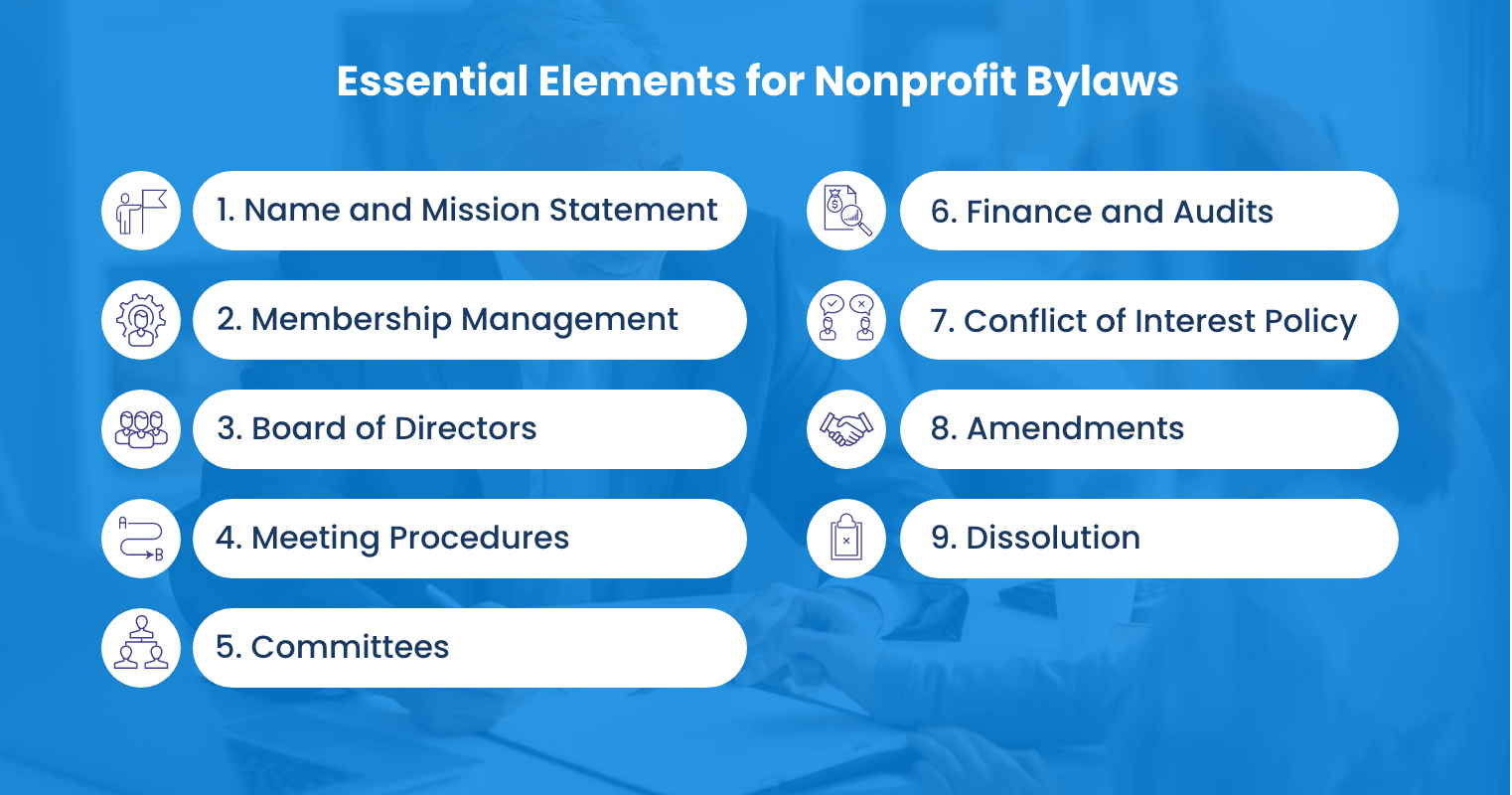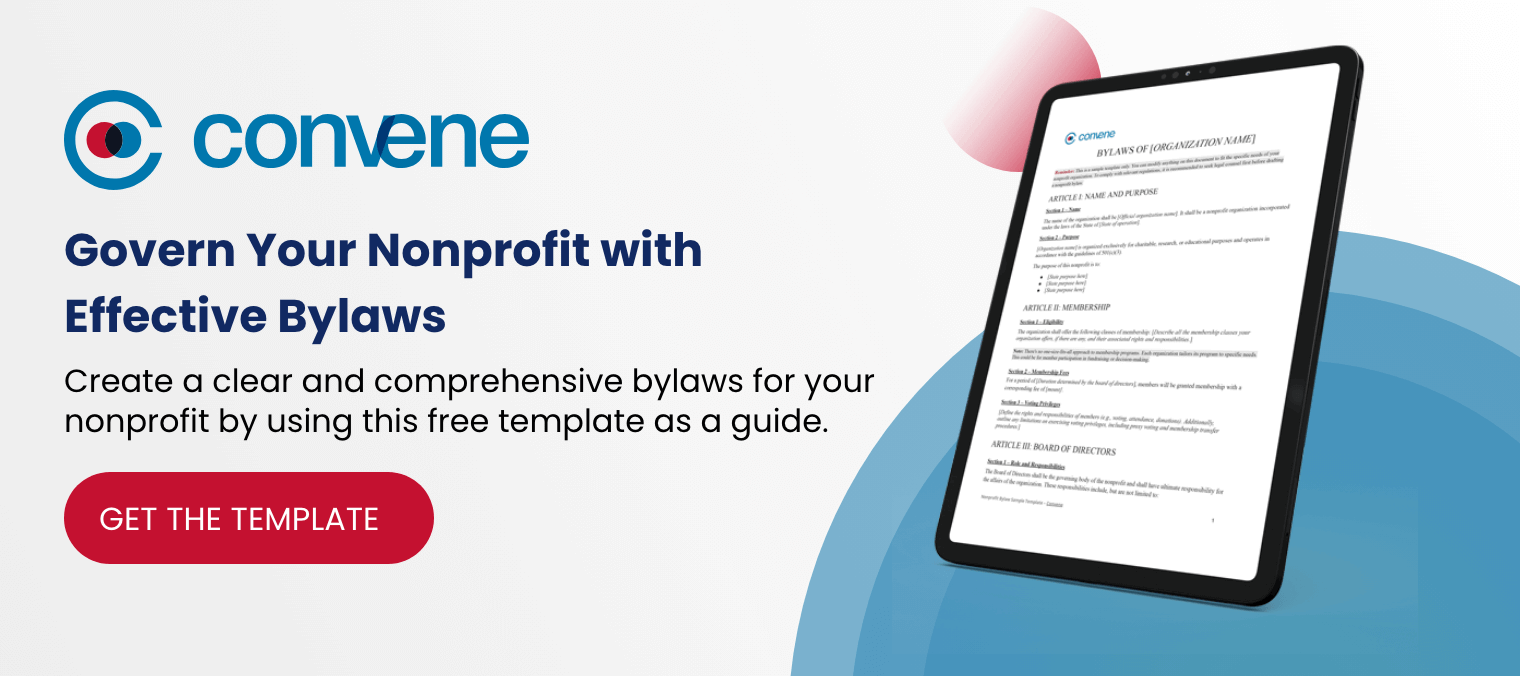

Every organization needs a structure and regulations to create a sense of order. For nonprofits, bylaws serve as their main governing document, outlining a list of actions the board should take to promote responsible decision-making and prevent conflicts among members.
However, failing to follow established bylaws can leave an organization prone to various risks like lacking clarity and direction, and vulnerability to legal disputes. Focusing on your bylaws can enhance governance and transparency, ensuring that your organization runs ethically and lawfully for years to come.
Here’s a comprehensive article about nonprofit bylaws, their essential elements, their benefits, and a guide to creating one. Download a free nonprofit bylaws template at the end to help you get started!
Nonprofit bylaws lay out the essential operational rules organizations use as the foundation for their governing structure. It has provisions on crucial matters such as membership, committees, amendments, and board compensation. They inform the board of directors with clear processes, influencing everyone to commit to responsible nonprofit governance.
While it’s essential to establish nonprofit bylaws as an organizational manual, they are also used to comply with relevant industry standards and state-specific regulations. Legislation in New York mandates nonprofits to include a provision for auditing, whereas Colorado doesn’t require its nonprofits to draft bylaws. However, the state highly encourages its nonprofits to adopt them as a foundation for good governance.

Bylaws are the backbone of effective nonprofit management. They guide decision-making, helping an organization achieve its long-term goals. If implemented properly, bylaws present a range of benefits, including:
Yes. Nonprofit bylaws are legal documents that dictate how the board of directors functions. Breaching bylaws can cause crucial implications such as:

Nonprofit bylaws inform their members and regulators of the organization’s purpose, mission, and organizational structure. They are unique to each organization, however, they generally have similar structures and functions. Established bylaws require the following elements:
Strong bylaws establish a clear organizational direction by introducing the nonprofit’s name, registered address, and mission statement. These elements provide the board, members, and the general public with a foundational understanding of the nonprofit’s nature and goals. Disclosing whether they are a nonprofit for religion, research, or educational activities helps manage expectations and promotes a more purposeful organization.
Members constitute a significant portion of an organization’s total population. In this case, sound policies are essential to maintain an organized and regulated membership base. Use this section to introduce regulations to your members, covering topics such as membership eligibility, voting rights, duties, and grounds for termination.
Bylaws should be definite with membership eligibility, fees, and procedures to increase appeal with potential members. This encourages more aspirants to prepare and submit requirements. Once accepted, members can refer to the bylaws to understand their rights and privileges, particularly on voting, access to programs, and discounts.
In cultivating engagement, the bylaws are reliable resources for educating members about their expected contributions. This outlines their duties, such as the required number of meeting attendance, volunteer hours, and membership renewal. Lastly, this section for the members must disclose grounds for termination and its due process to assert authority and hold better accountability.
Bylaws regulate nonprofit boards of directors and dictate how they make decisions. This part of the nonprofit bylaws explains election procedures, termination limits, board composition, governing structure, and duties and qualifications. Clarifying these aspects establishes a governance framework that ensures the board is held accountable for its fiduciary duties. Bylaws without clear guidelines on this aspect can leave the board adrift. This leads to confusion and mistrust among members and the public, potentially damaging the nonprofit’s reputation.
This section establishes the groundwork for how the board of directors can conduct productive and orderly meetings. It specifies the frequency of regular board meetings, whether monthly, bi-monthly, quarterly, or annually. For special meetings, the bylaws should clarify the process, including how the chair must obtain approval from the board and send out invitation notices.
Meetings are where directors gather to discuss and vote on pressing matters. To ensure effective decisions, meeting guidelines should be clear with the required attendance in meetings for the board to reach majority votes or quorum.
The board of directors relies on committees to focus on specific areas within the nonprofit. Guiding them in achieving their goals, bylaws outline how committees should operate by providing an internal governance structure. This section discusses crucial details such as composition, leadership, meeting cadence, and reporting hierarchy of each committee.
Special committees are created to address specific issues or projects outside the scope of existing standing committees. These committees are often temporary, disbanding after completing their task. Examples are special committees for fundraising campaigns, investigation of specific issues, or planning for special events.
Nonprofits rely on funding grants and donations to sustain operations. The public support they receive obligates them to be transparent and honest about their programs and financial standings. This section in the nonprofit bylaws covers provisions related to financial management, including how the board should conduct bookkeeping, manage the organization’s financial assets, prepare budgets for each fiscal year, and comply with financial and auditing reporting obligations.
A conflict of interest policy outlines how nonprofits can avoid situations where their private interests might conflict with their mission. This policy is essential for maintaining transparency, setting ethical boundaries, and preventing damaging situations. Nonprofit organizations include a conflict of interest policy in their bylaws to comply with IRS regulations and maintain their charitable status.
While the IRS doesn’t mandate specific language, a conflict of interest policy within your bylaws should incorporate the following elements: the purpose of the conflict of interest policy, the definition of terms, disclosure procedures, records of proceedings, compensation, annual statements, and periodic reviews.
Nonprofit bylaws are dynamic and are bound to adapt to changes over time. Amendment procedures are essential for nonprofits to keep their bylaws up-to-date with regulations and challenges. Use this section to build a comprehensive amendment process for the board and members. Indicate the voting thresholds, notice requirements, amendment sessions, and legal review process. Conducting transparent amendments empowers members, which enhances overall engagement. This, in turn, creates a more collaborative environment where everyone is involved in shaping the future of the nonprofit.
Dissolving a nonprofit is a legal process undertaken to permanently cease operations. While often a difficult decision, dissolution may be necessary for nonprofits lacking funding or effective programs. This section will provide a step-by-step guide to assist boards in careful planning for dissolution. The outline will include crucial steps such as developing a dissolution plan, notifying creditors, filing necessary paperwork, and distributing assets.
Struggling to write bylaws from scratch? Get a head start with our free nonprofit bylaw template below!

Strong bylaws are essential for nonprofits to ensure smooth operation and responsible governance. This guide will walk you through the key steps a nonprofit board should take to create effective bylaws.
The board of directors usually leads the drafting of crucial documents such as nonprofit bylaws. Their governance and management expertise are significant in ensuring they produce an output that is sound, legal, and effective.
For some nonprofits, however, the board of directors forms a bylaw committee. This approach enables the gathering of perspectives beyond the boardroom, allowing them to incorporate and reflect the real needs of their members. Once drafted, the bylaw committee is also responsible for submitting it to the board for approval and implementation by the entire organization.
Before officially drafting, it is best to seek legal counsel. Bylaws are legal documents and drafting them requires careful attention to comply with state-specific regulations and avoid legal challenges. Consulting with legal experts helps an organization identify all relevant legal requirements and draft the bylaws in the most suitable language. Poorly written bylaws can create vulnerabilities to costly lawsuits. Ultimately, legal counsel provides customized guidance specific to each nonprofit.
Reviewing bylaws should be part of nonprofits’ governance practices. Doing so helps identify conflicts arising from changes in legislation and ensures the organization continues to operate within legal boundaries. Additionally, as your organization’s goals evolve, regular review and modification help align the bylaws with those goals, promoting more effective governance in the future.
Nonprofit boards can seek tools to make these processes smoother and easier for members. Using board management software, the chair can schedule a series of meetings in advance for review sessions. The board can then prepare by sharing all relevant documents within the platform, providing greater accessibility for members. To explore this option, vendors offer free demos so your board can test its functionality before purchasing.
Here are some questions commonly asked about nonprofit bylaws.
IRS expects nonprofits applying for the 501(c)(3) status to submit their bylaws with other organizational documents. Submitting bylaws informs the IRS of how organizations plan to run their nonprofits following their charitable purpose This process helps them thoroughly assess a nonprofit’s eligibility for tax-exempt status by reviewing the organization’s governance practices and transparency measures. For sample bylaws for 501c3, you can download our nonprofit bylaws examples above.
Bylaws are not public documents. However, they can serve as reference documents for the IRS or state regulators to understand your organization’s purpose and governance structure. Sharing them with the general public is not an obligation for nonprofits, but your willingness to provide copies to those who request them demonstrates accountability and transparency, boosting public trust.
Articles of Incorporation (AoI) are a type of foundation document newly formed organizations file with government bodies to gain legal status. They detail the organization’s name, address, purpose, and the process for appointing the board of directors. On the other hand, bylaws act as an internal rulebook, providing a framework for how nonprofits should be governed. They detail various procedures such as member meetings, board of director elections, committee formation, and finances. The difference between the two mainly lies in their focus: an AoI defines the organization’s core existence and basic structure, while bylaws focus on internal governance and operational rules.

The adoption of modern governance in nonprofits continues to increase as societal issues and regulations become more complex. To make its implementation seamless, nonprofits utilize board portal software to streamline board management and bylaws maintenance, enabling more nuanced decision-making and governance.
Leading the board portal software market, Convene is a trusted provider by nonprofit organizations across the globe, empowering them to advance their governance and champion their causes. Convene comes with a suite of easy-to-use features for enhancing collaboration and productivity within organizations. It offers the highest level of data security, centralized document storage, interactive meetings, and automated pre- and post-meeting workflows—all designed to help nonprofits create a seamless and digital workflow.
Here are more benefits you expect from Convene:
Are you ready to take your nonprofit governance to the next level? Book a Convene demo to discuss how we can help you meet your requirements.
Share this article:
Jean is a Content Marketing Specialist at Convene, with over four years of experience driving brand authority and influence growth through effective B2B content strategies. Eager to deliver impactful results, Jean is a data-driven marketer who combines creativity with analytics. In her downtime, Jean relaxes by watching documentaries and mystery thrillers.